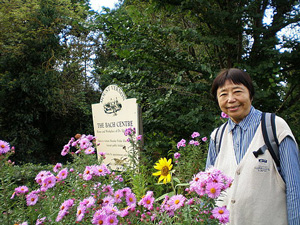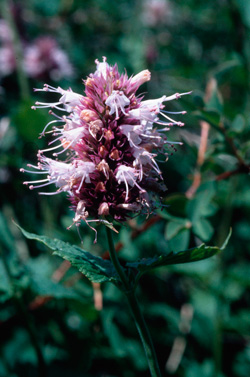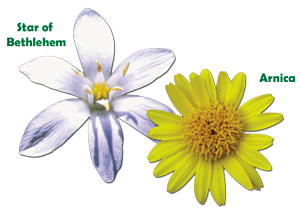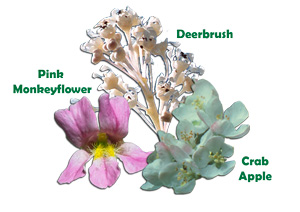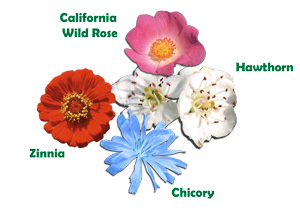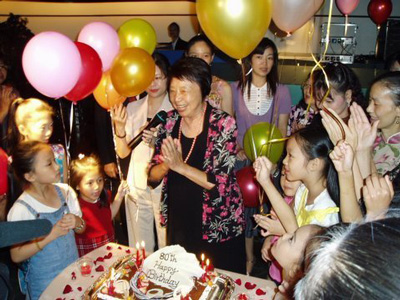
Utilizing electrol dermal screening, the late Dr. Julia Tsuei determined several flower essence combinations that are helpful for the emotions experienced by people with HIV/AIDS conditions. Most notably, essence combinations are helpful for shock and trauma, lack of self esteem, feelings of rejection by family and friends, resentment, and forgiveness. The essence combinations are detailed below.
By
Dr. Julia Tsuei
Combining modern and traditional medical services:
Flower essence therapy helps with the emotions that accompany HIV/AIDS
Study protocol and initial observations
Emotional relief results after use of flower essence combinations
Leading flower essence combinations
Combining modern and traditional medical services:
the work of Dr. Julia Tsuei
“In 1989, the late Dr. Julia Tsuei and a group of doctors and government officials in Taiwan established the Foundation for East-West Medicine to research the combined use of traditional and modern medicine. One year later, the group founded a sister organization called the Clinic for East-West Medicine, which became the first and only clinic providing a mix of modern and traditional medical services. Doctors use both systems to analyze the patient and to determine a method of treatment. For example, a patient suffering from diabetes might begin the visit with biochemical analyses such as urine and blood tests, then receive a traditional examination based on a Chinese medicine doctor's four steps of observation and questioning. Next, the patient might receive an analysis wherein a computerized ‘electrodermal screening device’ is pressed against a fingertip to measure…qualities to help determine physiological and psychological abnormalities. The patient's prescription might include anti-diabetic drugs plus a special restrictive diet supplemented by Chinese herbs.” 2 Since 1993, the clinic in Taiwan (and another one in Hawai’i) has served close to 4500 patients whose treatment included flower essence therapy. Utilizing the Electrol Dermal Screening Test (EDST), a measure of the acupuncture meridian system is taken to detect the pathology and determine the remedies needed. In 1997, Dr. Tsuei attended the Flower Essence Society Practitioner Training to further her studies in flower essence therapy. “After a detailed medical history is done, a set of 30 combination formulas of flower essence homeopathic preparations are tested through the meridian system using the psycho-neural pathways. One or two sets will be picked up indicating the emotional state of the client. Under the suggestion and guide of the determined formula, each individual flower essence will be tested, which are from either the 38 English Bach flowers or the 104 North American flowers developed by the Flower Essence Society. At most, five flower essences will be chosen based upon the degree of the energy rising from the client shown by further EDST testing. “After listening to the description of each flower essence from the Flower Essence Repertory written by Patricia Kaminski and Richard Katz, most clients respond immediately with ‘Oh! How true it is!’—and 30 – 40% with tears in their eyes throughout the session. A great number feel relieved, ‘At last someone understands me!’ Nearly 100% will follow the instruction to take the remedies, and more than 80% faithfully return and follow up with more visits.”
Flower essence therapy helps with the emotions that accompany HIV/AIDS
For two years, 2002-2004, a study was conducted at the clinic involving two groups of men:
As part of the holistic care program, the need for a flower essence combination formula, and the name and dosage of flower essences were tested by EDST.
Study protocol and initial observations of the emotional component of the HIV/AIDS condition
Group A
Initial findings
11 cases tested positive for SLFSTM (Lack of self esteem) and suffered from feelings of rejection.
Control Group B
None of the other essence combinations found in Group A including FRST-RSC (Trauma, shock) were found. Emotional relief results after use of flower essence combinations Initially, the testing of the HIV/AID patient group reflected their emotions when first finding out that they were infected with the virus. During their first visits, the FRST-RSC (First Rescue) combination was much needed because of the initial shock. The FRGV (Forgiveness) combination was also needed, probably due to the fact that they were rejected by their families, friends and employers. Many times, they were not able to forgive themselves as well. Compared with the control group before treatment, the ratio between these two groups for the need of FRST-RSC was 10/22 (Group A) and 0/22 (Control Group B); the need for FRGV was 10/22 and 1/22. However, after sixteen weeks of flower essence therapy, the test results reduced to 3/22 for the AID/HIV group for the need of FRGV and no need for FRST-RSC for both groups. This shows the definite therapeutic effect of the flower essences. The above observations reflect the fact that the HIV/AID patients as a group expressed a cluster of emotions; nearly all of them suffered from feelings of rejection and isolation resulting in resentment before treatment, as opposed to the control group. The feeling of shock and trauma is understandable, and the need for acute intervention is obvious. After treatment, there may have been some resentment remaining for the HIV/AID patients, yet the other common emotions experienced by the HIV/AID group did not persist. Leading flower essence combinations used for the emotional component of HIV/AIDS Following are the ingredients and indications for the flower essence combinations mentioned that were developed at the Clinic for East-West Medicine, which were used in the treatment of individuals with HIV/AIDS— “First Rescue” (FRST-RSC) is comprised of Arnica , Cherry Plum , Impatiens , Star of Bethlehem , Clematis , Rock Rose , Calendula , Self-Heal , Saint John’s Wort , Chamomile , Crab Apple , Indian Pink , Red Clover , Yarrow , and Angelica .
Its primary application is for symptoms related to trauma and shock. It is also used for:
It also indicates the need to check for tissue repair and stabilization after recent shock, and recent emotional events that have upset bioenergetic regulation.
Its primary application is for easing the effects of an unforgiving heart. It is also used for:
It also indicates the need to check for holding on to pain and resentment from the past, and blocked and stagnant energies from unresolved issues.
“Love and Joy”
(LVJY) includes Aloe Vera , Aspen , Hawthorn , Bleeding Heart , Borage , Holly , Yerba Santa , Mariposa Lily , Quince , California Wild Rose , Chicory , Zinnia , Mimulus , Mustard , Larkspur , Star Thistle , Sticky Monkeyflower , Sagebrush , and Nasturtium
Its primary application is for the relief of symptoms related to a harsh nature, unloving experiences and the suppression of playfulness and child-like joy. It is also used for:
It also indicates the need to check for the following:
The cluster of emotions the HIV/AID-carriers expressed in this study disturb mostly the heart (circulation), brain, lungs, endocrine glands, gall bladder, and liver. Since the HIV virus has the greatest impact on the immune system, such emotions would cause further damage if not compensated for in a timely manner. Editor’s note: Most of the information in this article was presented by Dr. Tsuei at the 2006 Bach Cromer Conference held in Norfolk, England. Footnotes 1 http://taiwanreview.nat.gov.tw/site/Tr/ct.asp?xItem=131&ctNode=119
2
The late Professor Julia Tsuei had over 40 years of experience in medicine and biomedical research, in particular, Traditional Chinese Medicine. She taught in various medical schools in the USA, Taiwan and China, and is well-acclaimed in the Chinese community of biological medicine research. Her research achievements in bridging east-west medicine have also earned her much recognition in the international arena, as demonstrated by the numerous awards she received in the past. These include the Lifetime Achievement Award granted by the International Institute for Advanced Studies in Systems Research and Cybernetics, Baden-Baden, Germany in 2001; the Founding Patron and Lifetime Member conferred by the American Association of Acupuncture and Oriental Medicine in 1991; as well as the Award for Outstanding Academic Achievement in Acupuncture Research granted by the Acupuncture and Moxibustion Society of China in 1990.
|

To install this Web App in your iPhone/iPad press ![]() and then Add to Home Screen.
and then Add to Home Screen.
